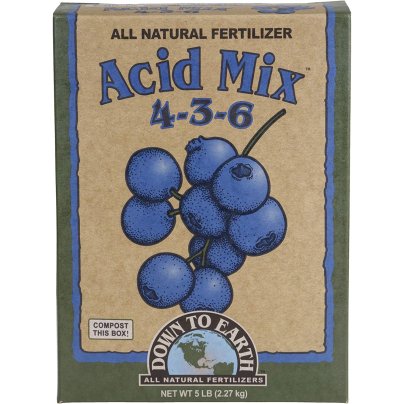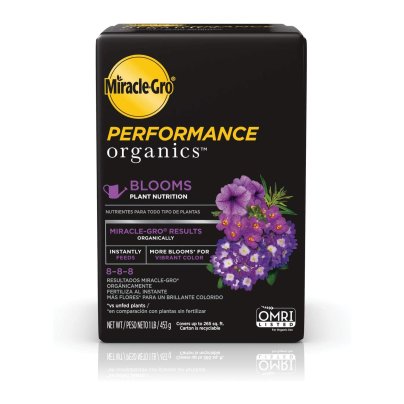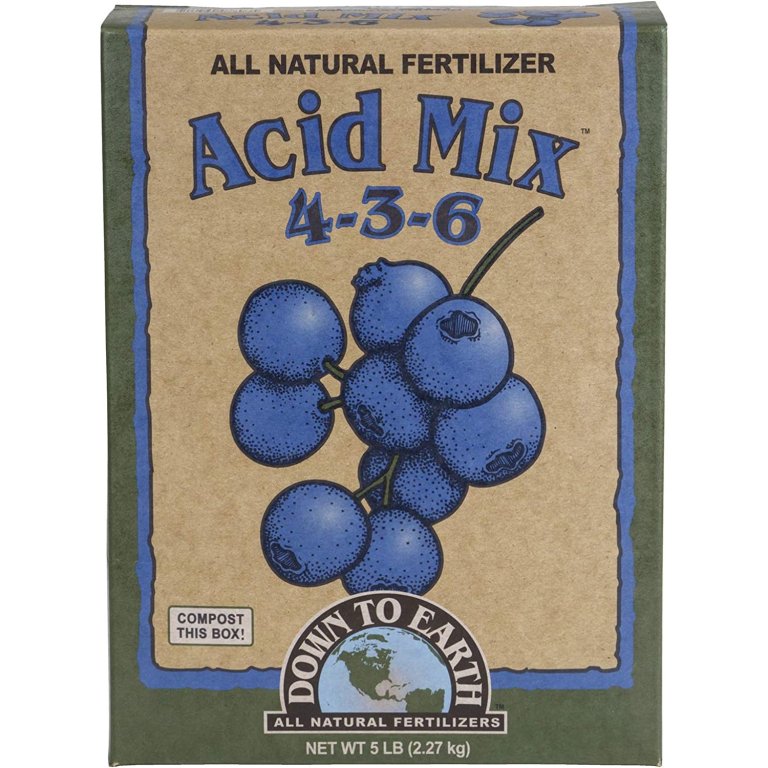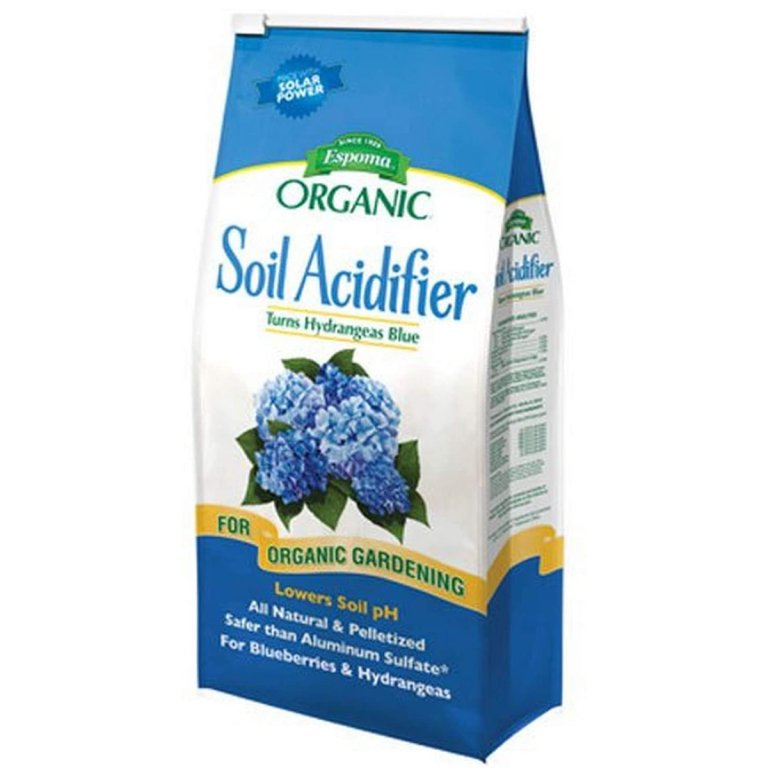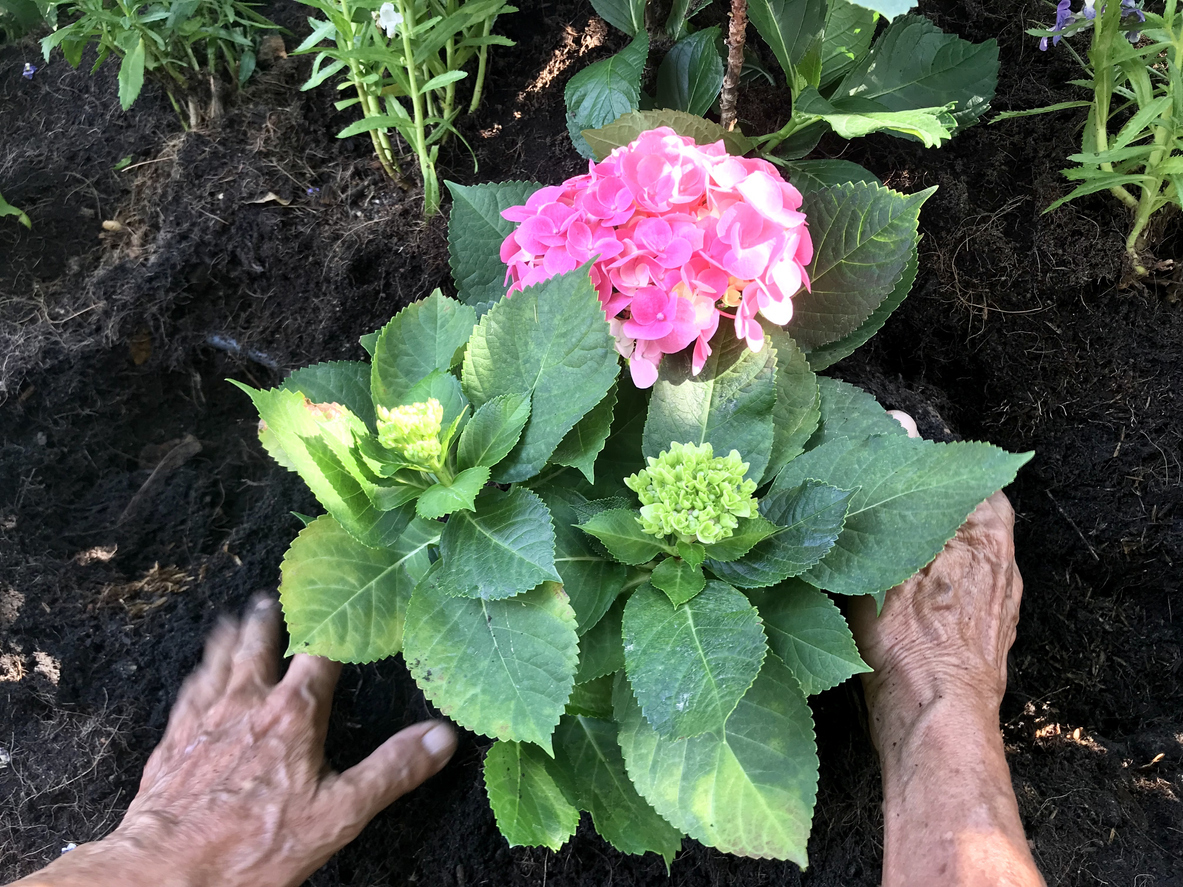
We may earn revenue from the products available on this page and participate in affiliate programs. Learn More ›
A perennial favorite in the landscape, hydrangea is hardy in a wide range of growing zones and is a relatively easy keeper. While hydrangeas vary in form, color, and bloom time, they are known for the large flower heads that cover the plants—so large, in fact, the blooms often weigh down the stems. Once established, the hydrangea is one of the summer season’s most impressive shrubs, but it needs fertilizer to reach its full potential.
The best fertilizer for hydrangea plants should contain a blend of nutrients to encourage healthy root and branch development while boosting the color, size, and quantity of flower heads. Don’t just grab a package of garden fertilizer off the shelf, though.
We recommend Espoma Organic Holly-Tone 4-3-4 as our top pick for its versatility, organic formulation, and availability. There are other common hydrangea fertilizer options on the market, including Miracle-Gro Acid-Loving Plant Food and JR Peters Jacks Classic Blossom Booster Fertilizer. However, they do not meet our sustainability guidelines and are not recommended in our top picks due to their potentially harmful ingredients and negative impact on the environment.
Learn what to look for when choosing a fertilizer for hydrangeas, and find out why the following products can help this impressive plant become a focal point in the landscape.
- BEST OVERALL: Espoma Organic Holly-Tone 4-3-4
- RUNNER-UP: Down to Earth All Natural Acid Mix Fertilizer
- BEST BANG FOR THE BUCK: Miracle-Gro Performance Organics Blooms Plant Nutrition
- BEST FOR BLUE: Dr. Earth Acid Lovers Organic Acid Fertilizer
- MOST VERSATILE: Dr. Earth GL61100518430 Fertilizer
- BEST ACIDIFIER: Espoma Organic Soil Acidifier
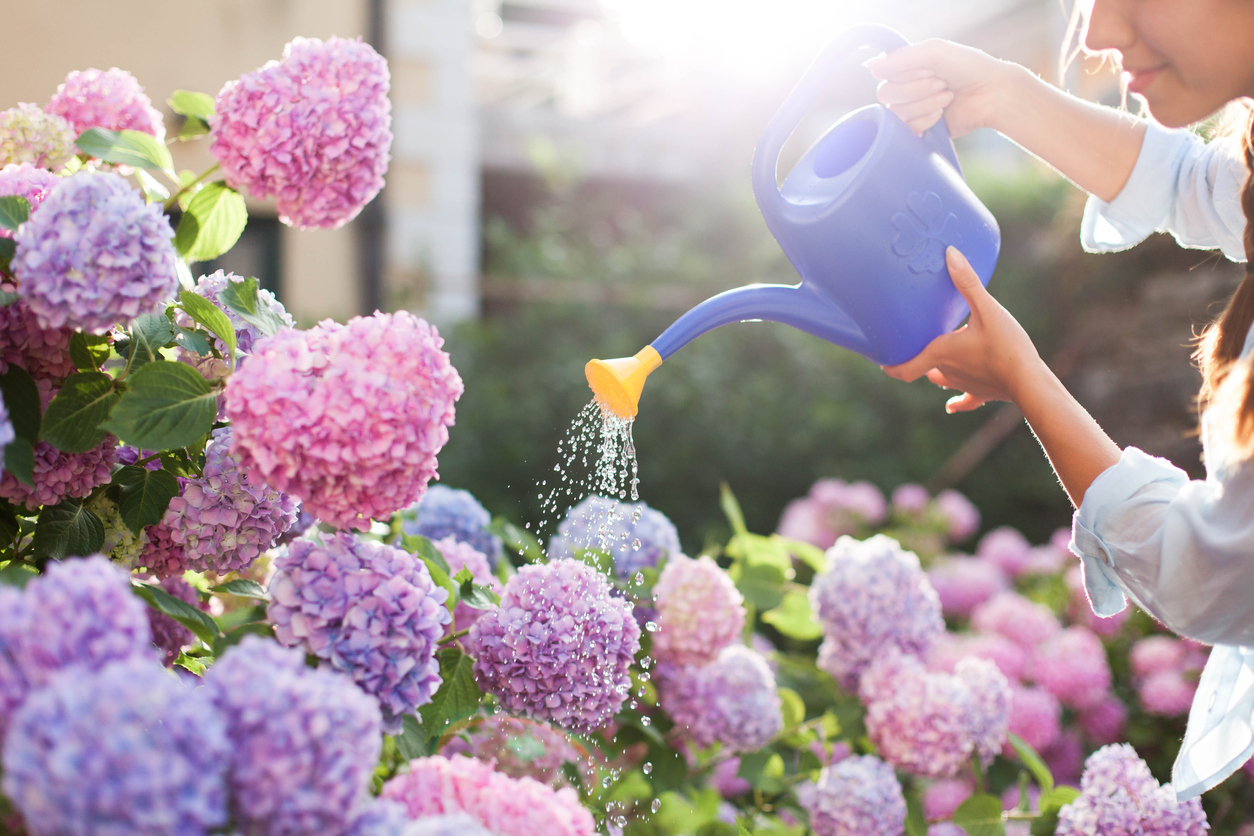
Before You Buy a Fertilizer for Hydrangeas
Before buying fertilizer for hydrangeas, it’s important to perform a soil test to determine the soil’s pH level and check for nutrient deficiencies. Hydrangea blooms will vary in color based on the acidity of the soil, and if the pH level is too high or too low, it can affect the plant’s ability to absorb essential nutrients from the soil. A soil test can also reveal if the soil lacks certain nutrients, such as nitrogen, phosphorus, or potassium, which can affect the plant’s growth and overall health. Knowing the soil’s pH level and nutrient content enables shoppers to choose the appropriate fertilizer and make any necessary amendments to ensure hydrangeas thrive.
Product Comparison
| Type | NPK Ratio | Quantity | |
| Espoma Organic Holly-Tone 4-3-4 | Granular fertilizer | 4-3-4 | Two 4-pound bags |
| Down to Earth All Natural Acid Mix Fertilizer | Liquid fertilizer | 4-3-6 | 5 pounds |
| Miracle-Gro Performance Organics Blooms Plant Nutrition | Water-soluble fertilizer | 8-8-8 | 1 pound |
| Dr. Earth Acid Lovers Organic Acid Fertilizer | Granular fertilizer | 3-4-3 | 4 pounds |
| Dr. Earth GL61100518430 Fertilizer | Granular | 3-9-4 | Two 4 pound bags |
| Espoma Organic Soil Acidifier | Soil acidifier | N/A | 6 pounds |
Our Top Picks
The best fertilizer for hydrangeas will vary depending on the gardener’s goals for this spectacular shrub. Any one of the following fertilizers is well suited for use on hydrangeas, but keep in mind that more is not necessarily better when it comes to fertilizing plants. Follow application instructions carefully. Do not overfeed hydrangeas; rather, err on the side of too little rather than too much and use fertilizer in combination with other soil amendments and an optimal growing location.
Best Overall
Espoma Organic Holly-Tone 4-3-4
What We Like
- Suitable for a wide variety of acid-loving plants
- Plants only need to be fertilized twice a year
- Available from major retailers at an affordable price
What We Don’t Like
- Might need extra applications on alkaline soil
- Smaller box than expected
Product Specs
- Type: Granular fertilizer
- NPK Ratio: 4-3-4
- Quantity: Two 4-pound bags
The best overall pick is an acid-based fertilizer from a well-known and respected manufacturer in the gardening industry. A granular plant food designed for hydrangeas and other plants that prefer slightly acidic soil, this fertilizer comes in a 4-pound bag of granules. It features a 4-3-4 N-P-K ratio to help hydrangeas get off to a robust start in spring and grow vigorously throughout the summer.
The plant food’s acid formulation gently reduces the soil’s pH level, increasing the chance the hydrangea flowers will be a deep pink, purple, or blue tone. Along with hydrangeas, this fertilizer works well for holly, azaleas, rhododendrons, blueberries, evergreens, strawberries, camellias, and other plants that thrive in acidic soils.
Get the Espoma Organic Holly-Tone 4-3-4 at Amazon or The Home Depot.
Runner-Up
Down to Earth All Natural Acid Mix Fertilizer
What We Like
- Suitable for a wide variety of acid-loving plants
- Contains macro-nutrients as well as magnesium and calcium
- Encourages colorful blooms
What We Don’t Like
- Must be applied monthly for the best results
Product Specs
- Type: Liquid fertilizer
- NPK Ratio: 4-3-6
- Quantity: 5 pounds
This acidic, granular fertilizer comes in a 5-pound bag and is suitable for use on many types of flowers and plants. One application will provide hydrangeas with a steady 4-3-6 N-P-K diet for about a month. In addition to the N-P-K nutrients, the fertilizer contains additional beneficial ingredients like calcium and magnesium as well as sulfur, which helps to make the soil more acidic.
Designed to encourage large, bountiful blooms, this fertilizer should be spread around the base of the plant at a ratio of 1 pound per 1 inch of trunk diameter. Along with hydrangeas, it’s a great pick for feeding rhododendrons, azaleas, camellias, evergreens, blueberries, raspberries, and strawberries.
Get the Down to Earth All Natural Acid Mix Fertilizer at Amazon.
Best Bang For The Buck
Miracle-Gro Performance Organics Blooms Nutrition
What We Like
- Includes both macro- and micro-nutrients
- Suitable for a variety of flowering plants
- Water-soluble fertilizers are easy to apply evenly
What We Don’t Like
- Must be applied weekly for the best results
Product Specs
- Type: Water-soluble fertilizer
- NPK Ratio: 8-8-8
- Quantity: 1 pound
There’s no need to spend a bundle on plant food. This affordable option features an 8-8-8 N-P-K formulation that promotes more blooms per shrub, along with vibrant flower heads. This is an all-purpose blossom booster that’s suitable for use on a wide variety of perennial and annual blooming plants, including hydrangeas.
It provides various minerals, including copper, calcium, and iron, to supplement common nutrient deficiencies. The water-soluble formulation should be applied every 7 days throughout the growing season for the biggest, brightest blooms and healthiest plants.
Get the Miracle-Gro Performance Organics Blooms Plant Nutrition at Amazon, Lowe’s, or The Home Depot (2.5 pounds).
Best For Blue
Dr. Earth Acid Lovers Organic Acid Fertilizer
What We Like
- Continuously feeds acid-loving plants for months
- Contains macro-nutrients, probiotics, and microbes
- Encourages vibrant blue blooms
What We Don’t Like
- Strong smell; could attract dogs or insects
Product Specs
- Type: Granular fertilizer
- NPK Ratio: 3-4-3
- Quantity: 4 pounds
Dr. Earth’s acid fertilizer contains only natural ingredients, including alfalfa meal, bone meal, and kelp meal, in a 3-4-3 N-P-K formulation. In addition to nutrients, it contains select strains of probiotics that improve soil health and increase plant performance. Some of its ingredients are designed to reduce the soil’s pH level, too, making the product suitable for use on all acid-loving plants and increasing the chances that hydrangeas will produce blue flowers.
For the best results, apply in mid-to-early spring and then every 60 days afterward. The granules should be mixed with the soil and watered well.
Get the Dr. Earth Acid Lovers Organic Acid Fertilizer at Amazon or The Home Depot.
Most Versatile
Dr. Earth GL61100518430 Fertilizer
What We Like
- Suitable for use on a variety of plants, trees, and shrubs
- Supplemented with probiotics for optimal overall plant health
- GMO-free formula
What We Don’t Like
- May encourage gnat infestations
Product Specs
- Type: Granular
- NPK ratio: 3-9-4
- Quantity: Two 4 pound bags
Dr. Earth Flower Girl has a 3-9-4 NPK analysis and includes additional probiotics to boost overall plant health, making it a great option for feeding bulbs, tubers, corms, and rhizomes. It contains eight strains of ecto- and endomycorrhizae, which work together to increase drought tolerance and provide enhanced nutrient availability.
The 4-pound bag of granules is designed to provide slow-release nutrients for several months after the initial application. The formula includes ingredients like fish bone meal, alfalfa meal, feather meal, soft rock phosphate, and mined potassium sulfate, and is GMO-free. It’s free of chicken manure and sewage sludge.
Get the Dr. Earth GL61100518430 Fertilizer at Amazon or The Home Depot.
Best Acidifier
Espoma Organic Soil Acidifier
What We Like
- Amends soil for acid-loving plants; creates blue blooms
- Doesn’t conflict with other fertilizers
- Only needs to be applied every 60 days
What We Don’t Like
- Does not provide plant nutrients
Product Specs
- Type: Soil acidifier
- NPK Ratio: N/A
- Quantity: 6 pounds
Gardeners and landscapers looking to create highly desirable blue flower heads need look no further than this soil acidifier from Espoma Soil. While not a strict fertilizer in the common sense—Espoma does not come with an N-P-K ratio—the product does contain elemental sulfur and gypsum that act together to lower the soil’s pH level, encouraging blue hydrangea blooms. For the best results, apply Espoma granules around the plant’s base in early spring before flowerhead buds develop and reapply every 60 days.
It comes in a 6-pound bag and is suitable for use on hydrangeas and other acid-loving plants. Be aware that pH levels adjust gradually. Depending on the soil’s current pH level, two or more applications may be necessary before the acidity is low enough to produce blue flower heads. This product can be used in conjunction with an all-purpose fertilizer to encourage robust plant health as well as blue flower heads.
Get the Espoma Soil Acidifier at Amazon or The Home Depot.
Or, DIY Your Own Fertilizer for Hydrangeas
One of the most effective and sustainable ways to make fertilizer for hydrangeas is by making compost from household scraps. Composting is a process of breaking down organic materials, such as fruit and vegetable scraps, leaves, and grass clippings, into nutrient-rich soil amendments that can be used to fertilize plants.
Start by collecting organic materials that are rich in nutrients, such as banana peels, eggshells, coffee grounds, and fish emulsion. Add them to an outdoor compost bin and mix in leaves and grass clippings.
Once the compost bin includes a good mix of materials, add some water and turn the compost pile regularly to provide oxygen and ensure even decomposition. As the compost breaks down, it will transform into a nutrient-rich soil amendment that can be added to the soil around the hydrangeas.
Not only is making compost a great way to provide hydrangeas with natural and healthy fertilizers, but it also helps to reduce waste and minimize environmental impact.
Jump to our Top Picks
How We Chose the Best Fertilizers for Hydrangeas
To keep hydrangeas growing and blooming bountifully, you need a fertilizer or soil amender that’s made specifically for these acid-loving plants. Our recommendations include a variety of options to help improve the health and beauty of these plants. We’ve selected traditional water-soluble fertilizers that help stimulate root growth, granular fertilizers, and soil amenders that help increase the soil’s acidity to achieve blue flowers.
To qualify as a top pick, a fertilizer should provide the nutrients hydrangeas need for developing strong branches, healthy foliage, and beautiful blooms. Our favorite options effectively increase the bloom rate of hydrangeas, and gardeners can choose between organic and non-organic products.
What to Consider When Choosing a Fertilizer for Hydrangeas
Like all plants, hydrangeas draw nutrients from water, sunlight, air, and soil, but not all soil contains the nutrients necessary for robust growth and flower development. That’s where hydrangea fertilizer can help. The best fertilizer for any individual hydrangea plant will depend on the gardener’s preferred method of delivering the fertilizer to the soil, and the condition of the existing soil.
Type
Hydrangea fertilizers come in three primary forms: liquid, granule, and compressed spikes. All three offer slightly different benefits.
- Liquid: Available as either a concentrate for diluting with water or a ready-to-use product, liquid fertilizers are quickly absorbed by the plant’s roots and leaves for a fast boost of nutrients. Depending on the product, liquid fertilizers are either sprayed on the plant’s foliage or poured around the plant’s base.
- Granules: One of the most common forms of fertilizers, granule fertilizers can either be dissolved in water and poured on the soil or sprinkled around the plant’s base. Time-release granules, which have a polymer coating, should be worked into the soil around the hydrangeas’ base with gardening tools. They dissolve slowly and offer the plant a long-term supply of nutrients.
- Spike: Like time-release granules, gardeners often use spikes if they’re looking for a long-term plant food. This fertilizer is compressed and shaped into hardened spikes that the gardener pushes into the soil around the plant’s base. Over the course of 2 or 3 months, the spikes slowly dissolve and provide nutrients for the plants.
Organic vs. Inorganic Fertilizers
Fertilizers are made up of either organic or inorganic ingredients.
- Inorganic: This type of fertilizer contains chemical and synthetic nutrients. It has been formulated in a laboratory to produce specific growing results, such as larger or more abundant blooms or an increased acidity level, which is desirable when growing hydrangeas. Inorganic fertilizers may also include time-released ingredients that dissolve slowly and feed the plant over a period of weeks or months. We’ve opted to exclude inorganic fertilizers from our recommendations because of their potentially negative impact on the environment.
- Organic: Many gardeners prefer using only natural fertilizers that contain ingredients such as earthworm castings, poultry manure, or compost. Organic fertilizers contain no chemicals, and they may not be as strong as inorganic fertilizers. They may, however, help increase soil health in addition to providing nutritional value. For example, compost doesn’t just provide the plant with essential nutrients; it also helps heavy clay soil drain better.
N-P-K Ratio
Commercial fertilizers are labeled by the amounts of nitrogen (N), phosphorus (P), and potassium (K) they contain by weight, which appears on the package as the N-P-K ratio. Hydrangeas will benefit from an all-purpose, balanced fertilizer, such as a 10-10-10 N-P-K, that contains equal amounts of each nutrient. A balanced fertilizer will encourage healthy foliage as well as bountiful blooms. For gardeners explicitly seeking to increase the blooms’ quantity and size, a fertilizer with a higher concentration of phosphorus (the middle number), such as a 10-20-10 N-P-K, may be beneficial.
Plant Needs
The hydrangea will tolerate partial sun, but it prefers a mostly shady spot in the yard. When possible, locate the shrub where it will not receive direct sun in the late afternoon in hot climates. Morning sun is usually acceptable and well tolerated. In northern climes where afternoon temps are moderate, some hydrangeas will also thrive if they receive some early afternoon sun. It’s the combination of hot temperatures and blazing sun that can take a toll on these spectacular shrubs. Hydrangeas like a permanent spot in the landscape, so planting them in pots or grow bags might not allow the shrubs to reach their full potential.
Soil Condition
Well-drained soil that’s high in organic matter is optimal for growing hydrangeas. Heavy, clay-type soil and sandy soil will benefit from additional organic matter, such as compost or dried leaves. By adding organic matter, the gardener will increase drainage and enhance the soil’s phosphorus level, which is favorable to producing colorful hydrangea blooms. Before amending soil, it’s a good idea to take a sample of the existing soil to a local extension office for testing. The test results will include recommendations for creating healthy, balanced soil.
Color and pH
White hydrangea species produce only white flower heads, but an interesting thing happens to colored hydrangeas when the gardener alters the soil’s pH level. The more acidic the soil’s pH, the more likely it is that the hydrangea flowers will be blue. The pH scale ranges from 0 to 14, with 7 considered neutral. Levels higher than 7 are considered alkaline, while levels lower than 7 are considered acidic. The greater the pH variation, the more pronounced the hydrangea color change.
- Neutral: At a neutral soil pH level, around 7, colored hydrangea will produce flowers in shades of pink to deep pink.
- Alkaline: At pH levels higher than 7, hydrangea flowers are a light, clear pink hue.
- Slightly acidic: When the soil’s pH is around 6, the blooms take on a dark pink or even slightly red or purple hue.
- Strongly acidic: When the soil’s pH level is lower than 6, hydrangea blooms tend to turn blue. This is the most desirable color for many gardeners, who regularly amend the soil to achieve beautiful blue flower heads.
When shopping for hydrangea fertilizers, you may notice that a good number of them are called acidic fertilizers. In addition to the product’s N-P-K nutrients, acidic fertilizers contain pH-changing additives, such as sulfur or aluminum sulfate. For those who strive for blue flower heads, it’s worthwhile to purchase a pH soil tester to monitor the soil’s pH level.
FAQs
Hydrangeas grow in most regions of the country and are prized for their spectacular blooms, so it’s natural to have a few questions about how to make the most of these eye-catching shrubs.
Q. When do hydrangeas start to bloom?
In warm climates, hydrangeas start to bloom in early summer. In northern climes, they bloom in mid-summer.
Q. What is the best time to fertilize hydrangeas?
It depends on the type of fertilizer. It’s a good idea to give hydrangeas a first feeding in mid-to-late spring. After that, apply additional fertilizer at intervals recommended by the manufacturer. Time-released fertilizers might need to be applied only once every 3 months, while other types should be applied every 1 to 2 weeks.
Q. How do I fertilize hydrangeas?
It’s essential to follow the directions on the product label. Liquids can be diluted and poured around the plant’s base or sprinkled on the foliage, while granules are often worked into the top inch or so of the soil. Fertilizer spikes are inserted near the base of the plant and pushed beneath the soil’s surface.

